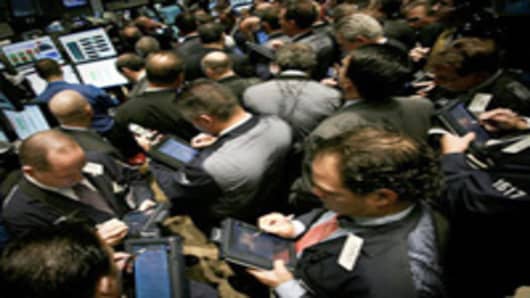Retail investors who normally would be expected to sell in May and go away may have just skipped the selling part—and have simply gone away.
In the face of a market downturn interrupted by brief rallies, the bulk of the action has come from institutional investors, with smaller players caught in a position where they have to hope the 10 percent correction doesn't turn into a 20 percent bear market.
The average investor appears loathe to buy stocks but is not in any particular hurry to sell, either, suggesting a protracted summer slog.
"It's all touch-and-go," says Kim Rupert, managing director of global fixed income analysis for Action Economics in San Francisco. "There's nothing clear-cut in this market. We're pretty much at the mercy of the news headlines."
Indeed, the market has been caught in a quandary since reaching correction losses that approached 14 percent. This week's trading has featured seesaw moves generated by anemic volume, with the day's results decided in the final hour when the pros take over.
Quick-hit headlines appeared again to be at play again Thursday, with the market surging on some global economic newsthat countered worries over European debt and an anemic jobs recovery in the US.
The Standard & Poor's 500 has fallen 13 percent since its April 23 high, and a growing chorus of analysts believe the market has returned to bear market conditionsand is poised for a further drop.
"It's formidable stuff," says John Stoltzfus, senior strategist at Ticonderoga Securities in New York, says of the many obstacles the market has to overcome. "Despite that we think these things will be overcome, but the process will be that tempered gains have to be earned."
The result has some investors feeling drained and ready to wait for the fall to come back before making any big decisions either way.
If the fairly tame CBOE Volatility Index is the market's favorite fear gauge, then the Investment Company Institute's weekly compilation of money market mutual fund assetsis its favorite apathy gauge. The figure is often called "money on the sidelines" in that it represents cash that is earning virtually no return and ready to be invested.
The most recent figure, from the week ended June 2, has the total at $2.84 trillion.
While that sounds like an enormous amount of dormant cash, it's actually the lowest since Sept. 30. 2007, just before the market's historical peak and as the worst of the financial crisis was about to hit. It is 37 percent below the historical high of $3.89 trillion on Jan. 31, 2009.
Moreover, in the past several weeks, retail investors actually have only modestly added money market positions, while institutional investors have taken out $12 billion and put their money to work to control the market movements.
Sentiment readings also show no signs of breakdown.
The Investors Intelligence Surveyfor the week ended June 1 had bulls outnumbering bears 39.8 percent to 28.4 percent—an uptick for the bulls and a drop for the bears.
And the VIX itself has shown no great leaps, either. While trading above the important 30 level, the fear gauge is about one-third what it was during the apex of the financial crisis.
"If you're in a market where investors are somewhere between skeptical and nervous, then this isn't capitulation. Investors are not panicking," Harris Private Bank Chief Investment Officer Jack Ablin told CNBC.com. "For anyone looking for an extreme in investor behavior, an extreme in investor sentiment, we're not there yet."
With weak trading volume and no strong conviction either way, the market could be in for a summer slog likely to put a sustained rally off until later in the year.
"The fear trade has not returned full bore. We're certainly not out of the woods yet," Rupert says. "Sovereign debt worries and fiscal problems are pretty much hitting every country. Those aren't going to be resolved soon, so I don't think this fear trade goes away anytime soon."
Many investors are following traditional safe-haven routes, taking positions in Treasurys and away from anything that even smacks of risk, despite some minor rallies this week.
"Investors often sell at the point where they just can't stand the pain anymore," says Beth Larson, principal at Evermay Wealth Management in Washington, D.C. "I would be very cautious about about doing any net selling in this market. If you have the right asset allocation as an investor, then I think you just have to gut this out, thinking that in the long run things will definitely be better."
Poor market sentiment has been reflected in a big drop in copper prices, which have fallen 22 percent since peaking on April 12. "Dr. Copper" as it is sometimes referred, is seen as a reliable gauge for market sentiment as copper is used heavily in growing economies.
"[W]e still think investors are likely to remain cautious given uncertainty about the long-term survival of the euro and parlous state of the public finances in many countries—both inside and outside the region," John Higgins, senior market economists at Capital Economics in London, wrote in a research note. "Even in those economies where fiscal policy is still supportive, the stimulus will fade next year and growth is likely to be slow."
With investors charting an uneasy course, the road out of correction territory is likely to be a long one.
"Everybody wishes they had sold in May and gone away," says John Stoltzfus, market strategist at Ticonderoga Securities in New York. "The beach weather has been pretty good. It would have been a nice thing to do in hindsight."




